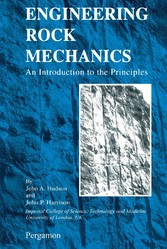Search and Find
Service
Front Cover
1
Engineering rock mechanics: an introduction to the principles
4
Copyright Page
5
Contents
8
Preface
12
Chapter 1. Introduction
14
1.1 The subject of rock mechanics
14
1.2 Content of this book
22
Chapter 2. Geological setting
24
2.1 Rock as an engineering material
24
2.2 Natural rock environments
27
2.3 The influence of geological factors on rocks and rock masses
29
Chapter 3. Stress
44
3.1 Why study stress in rock mechanics and rock engineering?
44
3.2 The difference between a scalar, a vector and a tensor
45
3.3 Normal stress components and shear stress components
45
3.4 Stress as a point property
46
3.5 The stress components on a small cube within the rock
47
3.6 The symmetry of the stress matrix
49
3.7 The state of stress at a point has six independent components
50
3.8 The principal stresses
50
3.9 All unsupported excavation surfaces are principal stress planes
51
3.10 Concluding remarks
53
Chapter 4. In situ stress
54
4.1 Why determine in situ stress?
54
4.2 Presentation of in situ stress state data
54
4.3 Methods of stress determination
55
4.4 Statistical analysis of stress state data
65
4.5 The representative elemental volume for stress
67
4.6 Predictions of natural in situ stress states based on elasticity theory
69
4.7 Collated worldwide in situ stress data
72
4.8 Reasons for high horizontal stresses
75
4.9 Effect of discontinuities on the proximate state of stress
78
4.10 Glossary of terms related to stress states in rock masses
81
Chapter 5. Strain
84
5.1 Finite strain
84
5.2 Examples of homogeneous finite strain
86
5.3 Infinitesimal strain
88
5.4 The strain tensor
90
5.5 The elastic compliance matrix
91
5.6 Implications for in situ stress
95
Chapter 6. Intact rock
98
6.1 The background to intact rock testing
98
6.2 The complete stress–strain curve in uniaxial compression
99
6.3 Soft, stiff and servo-controlled testing machines
102
6.4 Specimen geometry, loading conditions and environmental effects
108
6.5 Failure criteria
119
6.6 Concluding remarks
124
Chapter 7. Discontinuities
126
7.1 The occurrence of discontinuities
127
7.2 Geometrical properties of discontinuities
129
7.3 Mechanical properties
147
7.4 Discussion
151
Chapter 8. Rock masses
154
8.1 Deformability
154
8.2 Strength
157
8.3 Post-peak strength behaviour
160
Chapter 9. Permeability
162
9.1 Fundamental definitions
162
9.2 Primary and secondary permeability
164
9.3 Flow through discontinuities
164
9.4 Flow through discontinuity networks
167
9.5 Scale effect
169
9.6 A note on effective stresses
172
9.7 Some practical aspects: grouting and blasting
173
Chapter 10. Anisotropy and inhomogeneity
176
10.1 Definitions
176
10.2 Anisotropy
178
10.3 Inhomogeneity
179
10.4 Ramifications for analysis
182
Chapter 11. Testing techniques
186
11.1 Access to the rock
186
11.2 Tailoring testing to engineering requirements
187
11.3 Tests on intact rock
190
11.4 Tests on discontinuities
194
11.5 Tests on rock masses
199
11.6 Standardized tests
204
Chapter 12. Rock mass classification
206
12.1 Rock Mass Rating (RMR) system
206
12.2 Q-system
208
12.3 Applications of rock mass classification systems
211
12.4 Links between the classification systems and rock properties
214
12.5 Discussion
214
12.6 Extensions to rock mass classification techniques
215
12.7 Concluding remarks
219
Chapter 13. Rock dynamics and time-dependent aspects
220
13.1 Introduction
220
13.2 Stress waves
221
13.3 Time-dependency
226
13.4 Time-dependency in rock engineering
234
Chapter 14. Rock mechanics interactions and rock engineering systems (RES)
236
14.1 Introduction to the subject
236
14.2 Interaction matrices
238
14.3 Interaction matrices in rock mechanics
241
14.4 Symmetry of interaction matrices
242
14.5 A rock mechanics–rock engineering interaction matrix
245
14.6 Further examples of rock mechanics interaction matrices
248
14.7 Concluding remarks
249
Chapter 15. Excavation principles
252
15.1 The excavation process
252
15.2 Rock blasting
256
15.3 Specialized blasting techniques
261
15.4 Mechanical excavation
268
15.5 Vibrations due to excavation
274
Chapter 16. Stabilization principles
280
16.1 The effect of excavation on the rock mass environment
280
16.2 The stabilization strategy
282
16.3 Rock reinforcement
284
16.4 Rock support
287
16.5 Stabilization of 'transitional' rock masses
292
16.6 Further comments on rock stabilization methods
295
Chapter 17. Surface excavation instability mechanisms
300
17.1 Slope instability
300
17.2 Foundation instability
311
Chapter 18. Design and analysis of surface excavations
322
18.1 Kinematic analysis of slope instability mechanisms
322
18.2 Combined kinematic analysis of complete excavations
336
18.3 Foundations: stress distributions beneath variably loaded areas
338
18.4 Techniques for incorporating variations in rock and site factors into the analyses
343
Chapter 19. Underground excavation instability mechanisms
352
19.1 Structurally-controlled instability mechanisms
352
19.2 Stress-controlled instability mechanisms
359
19.3 A note on time-dependency and weathering
372
Chapter 20. Design and analysis of underground excavations
374
20.1 Design against structurally-controlled instability
374
20.2 Design against stress-controlled instability
387
20.3 Integrated design procedures
405
References
406
Appendix A: Stress and strain analysis
412
Appendix B: Hemispherical projection
444
Index
454
All prices incl. VAT











